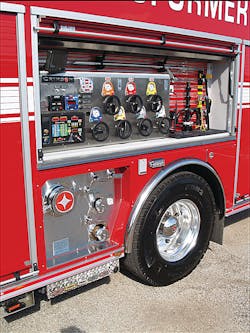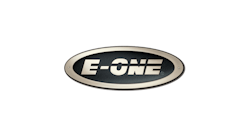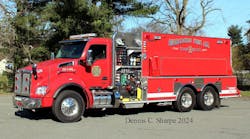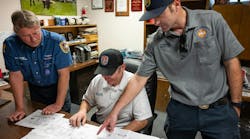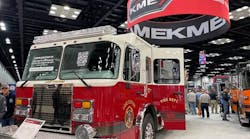With only about six weeks between the Fire Department Instructors Conference (FDIC) in Indianapolis and the Interschutz international show in Leipzig, Germany, which is arguably the largest fire show in the world, some manufacturers were saving their big unveilings for the show in Germany, which happens only every five years. Therefore, there weren't as many product debuts at FDIC as there have been in years past. Although the numbers were diminished, the apparatus unveilings at FDIC were still impressive.
Crimson Fire Transformer and FRAC
Crimson Fire introduced an apparatus at the show called the Transformer, which really is a transformative apparatus in the fire service.
Lately, there's been stiff industry competition on how best to preserve valuable compartment space. When it came time for Crimson Fire, a subsidiary of Spartan Motors, to try its hand at playing with the pump location, Paul Cressman, a shop foreman for Crimson Fire, had an idea.
"I went to management and said, 'I've got an idea that's a little out of the box,'" he said. "They asked how far out and I told them, 'in the neighbor's front yard.'"
Cressman had come up with an idea to locate a PTO pump just in front of the left rear tire, in an area that is often wasted with wheel wells and dead space.
Crimson and its engineers determined that it was an appropriate place for a 1,500-gpm Darley pump. The geometry of the drive shafts actually worked better with a gradual angle to the left of the transmission.
Crimson Fire refined an idea for the pump valve controls too, employing hydraulic valves actuated by cranks on the control panel that pump fluid to the valves. The new system allows the control panel to be located above the rear wheels on the driver's side in a compartment that is often underutilized. The configuration preserves all the space in the cab as well as the all-important first cabinet, which can be configured in any way a department desires, including transverse.
Crimson also introduced a new configuration of its First Response All Calls (FRAC).
The new vehicle also incorporates Crimson's new pump location - in front of the left rear wheel - to provide more space for compartments and other equipment needs.
As shown, the FRAC was equipped with a 1,250-gpm PTO pump, a 250-gallon water tank, a 125-cfm compressed air foam system and a walk-in command center in the rear of the apparatus.
It can be configured as an ambulance or patient transport vehicle, a hazmat vehicle, and also as a lighting, equipment support, and rescue vehicle. The space can also be used for ATV transport. It was built on a Furion cab and a chassis built by Spartan Motors.
Jim Salmi, Chief Operating Officer of Crimson Fire, is considered a guru when it comes to aerials and he did not disappoint when he came up with a new hydraulic hosebed called the HydraLoad. The new device, developed by Salmi, lowers the hosebed of an aerial to 20 inches off the ground and deploys from a place previously unusable in the aerial torque box.
It deploys less than 35 inches from the side of the body and features an interlock with the aerial outriggers to prevent the hosebed from colliding with the stabilizing device. It can accommodate 1,000 feet of 5-inch hose or up to 1,500 pounds of hose in any configuration. It deploys in 20 seconds.
"And it's just as smooth as can be through its full range of motion," Salmi said.
Oshkosh Corporation Striker
Oshkosh made a splash of its own with a new Striker Aircraft Rescue and Fire Fighting (ARFF) vehicle.
The 6-wheel drive vehicle is a product of many "voice of the customer" conferences and discussions, according to Oshkosh representatives.
One of the things Oshkosh heard, and answered, was the need for accessible crosslays to give firefighters alternate, and perhaps more traditional, ways to fight fire.
Two mid-drift height crosslays, accessible from both sides of the apparatus, flow water and water/foam combinations.
Firefighters and ARFF users repeatedly requested a centralized access spot for all filters, fluids and maintenance items. Oshkosh answered that request by creating a walk-in service port at the rear of the apparatus. All fluids and filters can be checked and changed from that one spot, according to the manufacturer.
Oshkosh is particularly proud of the improved visibility the new Striker offers and redesigned ergonomics for the driver and occupants, including things like cup holders. Oshkosh representatives said that little detail is more than a convenience considering ARFF firefighters are often asked to stand by for hours as aviation emergencies unfold.
The Striker was unveiled with much fanfare at a pre-show reception with indoor pyrotechnics, lights and music.
"We believe we have developed the most advanced firefighting apparatus in the world," said Wilson Jones, Oshkosh Corporation executive vice president and president of Pierce.
"We did not do this alone," Jones told the hundreds of people who jammed the booth. "Using the voice of the customer strategy, this new Striker was designed with the help of firefighters from around the world. We are serious about voice of the customer."
The Striker is the product of three years of work and interaction with the customer, Jones said, telling the gathered audience to "see for themselves."
Pierce Manufacturing Engines
Also at the show was Pierce's redesigned Detroit Diesel engine exclusively for fire apparatus and available only through Pierce.
A few years ago, the engine manufacturer decided it wasn't going to offer Detroit Diesel products for fire service use. Pierce, which had been using Detroit Diesel engines as power plants for its apparatus for years, wasn't about to take that lying down.
Detroit Diesel engines would not physically fit into fire apparatus and the fuel intake and emissions systems needed to be relocated to improve clearances. Because the Detroit Diesel engine was so important to Pierce's product offering, it dedicated its own resources and engineering staff to make the modifications to the engine for use exclusively in Pierce apparatus.
The modifications resulted in a 2010 EPA compliant engine based on the DD13 platform which is exclusively for Pierce apparatus.
The new engine configuration improves fuel economy by five percent while delivering up to 500 hp and 1,650 foot pounds of torque on demand. More importantly, the new engine package doesn't require any additional wheelbase length, or adversely affect cab and compartment space.
KME Ultra-High Pressure Pump
High pressure pumps have been around for a long time, but recently, they've made a resurgence.
KME Fire Apparatus unveiled a pumper with an HMA Fire ultra-high pressure suppression system at the show.
According to Phil Gerace, KME's director of sales and marketing, the high pressure pump saves water and reduces water damage. He also said it's different from other high pressure pumps because it is even higher pressure than the old John Bean pumps. The ultra high pressure, boosting it to up to 1,200 to 1,400 psi, makes the difference.
The system, which is mounted in a compartment on one of KME's pumpers, is said to be more effective and efficient in fire suppression, using less water with smaller droplets. According to HMA, the system has a constant output from 16 to 22 gpm at ultra high pressures. The system can deliver foam or straight water and is three times more efficient than traditional systems, according to KME and HMA.
KME's show pumper featured both the traditional midship pump and the HMA ultra high pressure pump.
KME Aerial Platform
KME also used the 2010 FDIC show to release its newest aerial platform design for both rear and midmount aerials.
The new platform offers 25 percent more room for occupants and is now 20.8 square feet, according to the maker, comfortably accommodating four firefighters with SCBAs and equipment.
The platform corners are angled to avoid interfering with the front or rear turning radius. The new platform is also equipped with a new push-type latch allowing firefighters hands-free access to the platform.
KME also substantially increased visibility on the platform and the rungs with "Pathfinders" LED illumination lights on the ladder rails and the platform floor. NiteSafety photo luminescent covers have been installed on ladder rungs and on the platform floor for improved visibility.
E-ONE Severe Service Cab
E-ONE debuted its severe duty cab at the show in the Lucas Oil Stadium.
The interior has virtually no formed and molded plastic which is prone to cracking when slammed by firefighters and their gear.
Nearly all surfaces are either painted with Zolatone or covered with aluminum or even stainless steel plating, said Amanda Davis Gummer, E-ONE's marketing and communications manager.
"This is for departments that are tough on their trucks," she said, pointing out the features.
According to the manufacturer, the new interior uses .125-inch aluminum with Zolatone paint for the center dash, officer's side dash and the "A" post covers.
The engine cover has a .125-inch WearTrak cover with .375-inch foam insulation to dampen noise.
The concept is to eliminate the ABS interior trim adopted about 25 years ago that allowed for automotive styling, but did not stand up as well to the rigors of fire apparatus.
The new cab interior also features a recessed mobile data terminal (MDT) provision for the officer, an officer's glove box with hinged door, barrier style doors, and door panels constructed of 14-gauge brushed finish stainless steel or .125-inch aluminum painted to match the cab interior.
According to E-ONE, the severe service cab also offers more options for equipment mounting, such as radios, speakers, monitors, chargers and other items.
HME Ahrens-Fox Compressed Natural Gas Powered Engine
One apparatus that generated a buzz was the compressed natural gas powered engine unveiled by HME Ahrens-Fox, and it wasn't just the green rainforest tree frog decals adorning the apparatus that caused the buzz.
According to Dave Fornell, HME's director of marketing, the apparatus was the first of its kind to be powered by compressed natural gas (CNG).
"We're getting a lot of interest in this," Fornell said as show goers swarmed over the apparatus, checking under the cab to see how it ran and how the CNG tanks were stored.
"This is a very quiet apparatus with a lot of power," said Fornell.
The biggest advantage of the Cummins Westport engine-powered apparatus is it meets the EPA and California Air Resources Board (CARB) 2010 emission requirements without Diesel Exhaust Fluid (DEF) and Selective Catalytic Reduction (SCR) systems that are required on diesel engines. Its exhaust system is comprised of a simple, three-way catalyst that meets the EPA useful-life requirement and is maintenance-free.
Rosenbauer America Green Star
If it weren't for the green lights under the apparatus, a showgoer might not have even noticed Rosenbauer's new Green Star apparatus.
That's a good thing - it's not supposed to be noticed. Its true value is supposed to be seamless integration of a generator into the apparatus's electrical systems to reduce emissions by shutting off the large apparatus engine. The power is replaced by electricity generated by a small, diesel-fired generator instead of maintaining power by letting the apparatus's large diesel engine idle.
A big-block diesel-powered engine found in many apparatus consumes fuel at the rate of 1 gallon per hour at idle, while the APU system burns fuel at the rate of one quart per hour, a savings of up to 75 percent, Rosenbauer said.
By shutting off the main engine, fire departments can not only save fuel, they can save on diesel particulate filters and components and emission system maintenance. Rosenbauer says its APU system can also work as a gen-set to power scene lighting and all other electrical components required at a typical fire scene.
There is no need for a secondary generator for those components and the APU gen-set can be started from inside the cabin or at the pump control, as customarily found on apparatus equipped with generators. Therefore, the APU Green Star adds very little cost to apparatus that have generators specified.
Should demand for power exceed the APU's ability to produce power, the system will automatically restart the apparatus chassis mounted engine and resume idle to produce the power without any interruption.
